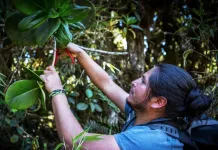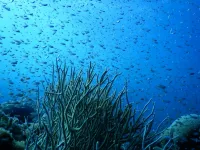(Press-News.org) The Andes Mountains of South America are the most species-rich biodiversity hotspot for plant and vertebrate species in the world. But the forest that climbs up this mountain range provides another important service to humanity.
Andean forests are helping to protect the planet by acting as a carbon sink, absorbing carbon dioxide and keeping some of this climate-altering gas out of circulation, according to new research published in Nature Communications.
The study -- which draws upon two decades of data from 119 forest-monitoring plots in Colombia, Ecuador, Peru, Bolivia and Argentina -- was produced by an international team of scientists including researchers supported by the Living Earth Collaborative at Washington University in St. Louis. The lead author was Alvaro Duque from the Universidad Nacional de Colombia Sede Medellín.
"Based on the information that we have, Andean forests are a carbon sink -- capturing more carbon than they emit," said J. Sebastián Tello, a co-author of the study and a principal investigator for the Living Earth Collaborative working group titled, "A synthesis of patterns and mechanisms of diversity and forest change in the Andes: A global biodiversity hotspot."
"The amount of carbon that is stored in the aboveground biomass in the stems and leaves of trees is actually increasing through time, potentially offsetting some of the carbon dioxide emissions that are released to the atmosphere," said Tello, an associate scientist at the Center for Conservation and Sustainable Development at the Missouri Botanical Garden.
Tello leads the Madidi Project, a long-term study that the Missouri Botanical Garden has supported for nearly 20 years, involving plant diversity and forest change in Bolivia. Twenty-six of the forest plots included in this study were from the Madidi Project.
"Two critical research questions are how and why the functioning of ecosystems is being impacted by climate change," added Jonathan Myers, associate professor of biology in Arts & Sciences at Washington University, another co-author of the new study. "Carbon storage is one of the most important ecosystem services that helps to mitigate the effects of rising carbon dioxide levels under climate change and temperature warming.
"This study provides insights into how species on the move, under climate change, might be impacting these broader ecosystem services important to humanity," Myers said.
Carbon is an important building block of life on Earth, but the element contributes to global warming when it is released into the atmosphere as carbon dioxide. Living plant tissues such as the stems, bark, branches and twigs of trees can act as a carbon sink because they absorb carbon dioxide from the atmosphere during photosynthesis.
By locking in carbon, trees in forests around the world play a role in maintaining global climate stability. Some forests play a bigger role than others -- the Andes prime among them, the study found.
Tropical and subtropical ecosystems are believed to account for nearly 70% of all the carbon sequestered by Earth's forests. But previous estimates of tropical carbon uptake were largely based on studies of lowland ecosystems, such as the Amazon.
This study incorporates data from forest plots spanning a range of more than 3,000 meters (10,000 feet) in elevation across the subtropical and tropical Andes. The results indicate that the Andes are similar to other tropical forests in that they are acting as aboveground carbon sinks. However, the overall relative strength of the Andean carbon sink exceeds estimates from previous studies conducted in lowland tropical forests in Amazonia, Africa or Southeast Asia, the researchers discovered.
Factors such as precipitation, temperature and size-dependent mortality of trees tend to drive carbon storage dynamics in Andean forests.
Because of its vast size, the Amazon forest currently accumulates more carbon than the Andean forest. But recent research has suggested that the Amazon might become saturated with carbon in the near future. Under this scenario, the continued net uptake of carbon in Andean forests will become even more important.
As a neighbor to the relatively well-studied Amazon forest, much about Andean forest ecosystems remains comparatively unknown. Challenging mountain terrain combined with remoteness makes it harder for scientists to reach parts of the Andes. It's also hard to secure funding to support large-scale research projects that span multiple countries.
"This paper collects and integrates information from lots of different research groups that have been working for decades independently," Tello said. "It's one of the first big efforts to bring together the scientists who have been monitoring these forests."
William Farfan-Rios, a native of Cusco, Peru, and a postdoctoral research fellow of the Living Earth Collaborative, knows first-hand how difficult it is to conduct field research in the Andes. Since 2003, he has coordinated and led field campaigns and research projects with the Andes Biodiversity and Ecosystem Research Group, working along an elevational transect between the Andean and Amazonian forests in Peru. Farfan-Rios is also a co-author on the new study.
Farfan-Rios recalled the challenges associated with one particular forest survey effort, saying: "At the beginning, we were a team of 14 people from Cusco. And, at the end, I was the only one who was still surveying those plots. I was the only survivor of this initial team! Right now, I'm still collaborating with that group and using this information for my postdoc with the Living Earth Collaborative."
In only 1% of the Earth's land surface, the tropical Andes contain 15% of the world's plant species, or about 45,000 species in total. Approximately half of these plants -- about 20,000 species -- are endemic, meaning they are only found in the Andes. In addition to harboring extreme levels of biodiversity, Andean forests provide and protect sources of food, water and power for more than 50 million people. However, global environmental change -- including deforestation, human population growth and climate change -- is endangering Andean biodiversity and ecosystem services.
"Building on William's research and the finding that Andean forests are important carbon sinks and targets for conservation, it's important to understand how upward species migrations that are occurring under climate change might sustain those ecosystem services or functions in the future," Myers said. "Conservation initiatives not only support current forest biodiversity, but also habitats for species that will migrate to new areas in the future."
INFORMATION:
This research was funded in part by the Living Earth Collaborative and the International Center for Energy, Environment and Sustainability at Washington University.
A team of scientists from Russia studied the role of double-stranded fragments of the maturing RNA and showed that the interaction between distant parts of the RNA can regulate gene expression. The research was published in Nature Communications.
At school, we learn that DNA is double-stranded and RNA is single-stranded, but that is not entirely true. Scientists have encountered many cases of RNA forming a double-stranded (a.k.a. secondary) structure that plays an important role in the functioning of RNA molecules. These structures are involved in the regulation of gene expression, where the double-stranded regions typically carry specific functions and, if lost, may cause severe disorders. A double-stranded structure is created by sticky complementary ...
New, detailed study of the Renland Ice Cap offers the possibility of modelling other smaller ice caps and glaciers with significantly greater accuracy than hitherto. The study combined airborne radar data to determine the thickness of the ice cap with on-site measurements of the thickness of the ice cap and satellite data. Researchers from the Niels Bohr Institute - University of Copenhagen gathered the data from the ice cap in 2015, and this work has now come to fruition in the form of more exact predictions of local climate conditions.
The accuracy ...
A new study led by researchers at Johns Hopkins and the University of Pennsylvania uses computer modeling to suggest that eviction bans authorized during the COVID-19 pandemic reduced the infection rate and not only protected those who would have lost their housing but also entire communities from the spread of infections.
With widespread job loss in the U.S. during the pandemic, many state and local governments temporarily halted evictions last spring, and just as these protections were about to expire in September, the Centers for Disease Control ...
Alzheimer's disease (AD) is a form of progressive dementia interfering with daily living. It is caused by the decline in the number of brain cells resulting in the deterioration of our mental abilities. One of the main reasons for the worsening brain cells condition and even the brain shrinkage are molecules having a specific structure called β-amyloids (Aβ). They are peptides that tend to agglomerate around the nerve cells, becoming toxic and damage them. Recent studies, presented by scientists from the Institute of Physical Chemistry, Polish Academy of Sciences, led by dr. Piotr Pieta, give hope for inhibition of the β-amyloids' toxicity by applying the K162 molecule. Researchers present a tremendous protective impact on the biological membranes ...
UPTON, NY--Scientists have identified the primary cause of failure in a state-of-the-art lithium-metal battery, of interest for long-range electric vehicles. Using high-energy x-rays, they followed the cycling-induced changes at thousands of different points across the battery and mapped the variations in performance. At each point, they used the x-ray data to calculate the amount of cathode material and its local state of charge. These findings, combined with complementary electrochemical measurements, enabled them to determine the dominant mechanism driving the loss of ...
A joint research carried out by MIPT scientists and Harvard researchers have presented retinal cells that can integrate into the retina. This is the first successful attempt to transplant ganglion cells (retinal neurons that are destroyed by glaucoma) derived from stem cells in a lab setting. Scientists tested the technology in mice and established that the cells successfully integrated and survived for a year. In the future, the researchers plan to create specialized cell banks, which will permit individual, tailored therapy for each patient.
The world's first successful attempt to grow and transplant ...
COVID-19 patients who are overweight or obese are more likely to develop a more severe infection than patients of healthy weight, and they require oxygen and invasive mechanical ventilation more often. There is no increased risk of death . These conclusions, for which more than 7,000 patients were studied, appear from international research in eleven countries, including the Netherlands (Radboud university medical center).
The study, led by Australian researchers, examined over 7000 patients from eleven different countries who were admitted to 18 hospitals. Of this group, over a third (34.8%) were overweight and almost a third (30.8%) were obese. COVID-19 patients with obesity required ...
Coral reefs are one of the most biologically diverse ecosystems on earth. In the northern Red Sea and Gulf of Aqaba corals also have exceptionally high tolerance to increasing seawater temperatures, now occurring as a consequence of global warming. This characteristic led coral reef scientists to designate this region as a potential coral reef refuge in the face of climate change - a reef where corals may survive longer than others that are being lost at an alarming rate due to human pressures.
However, global climate change will also result in more variable weather patterns, including extreme cold periods. Some researchers predict that the Red Sea region is entering a cooling phase. Therefore, researchers from Bar-Ilan University and ...
Making space in high street shops for people to repair clothes could mend the damage caused by fast fashion and transform sewing into a wellbeing activity, experts say.
More resources and opportunities for people to embrace slow fashion could also save people money, help them learn new skills and create new business opportunities.
A new study suggests a variety of ways in which consumers might be encouraged to change their clothing purchasing behaviour, depending on their personality traits. One way to do this might be by marketing making and mending expertise as the "hipster's' equivalent of a spa day".
Fast fashion has emerged in the last few decades as clothes have become cheaper, less durable and are purchased more frequently. This has resulted in severe negative environmental ...
WASHINGTON -- Researchers are blurring the lines between science and art by showing how a laser can be used to create artistic masterpieces in a way that mirrors classical paints and brushes. The new technique not only creates paint-like strokes of color on metal but also offers a way to change or erase colors.
"We developed a way to use a laser to create localized color on a metallic canvas using a technique that heats the metal to the point where it evaporates," said research team leader Vadim Veiko from ITMO University in Russia. "With this approach, an artist can create miniature art that conveys complex meaning not only through shape and color but also through various laser-induced microstructures on the ...






